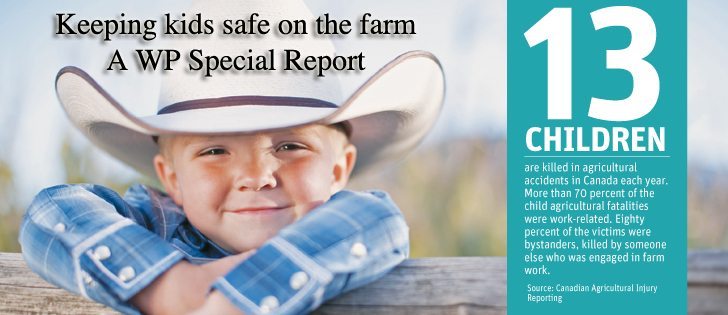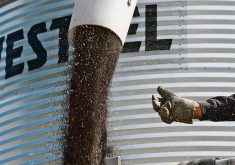Accidents happen in all occupations but farming is particularly dangerous because it’s where families live, play and also work. The tasks change with the seasons, but the risks to children are constant and the youngest family members are often the most vulnerable.
Farm parents are no different than other parents, except that they live, work and raise families in a highly hazardous environment.
Will Pickett, a public health sciences professor at Queen’s University, said keeping tabs on children at all times is paramount.
Read Also

Know what costs are involved in keeping crops in the bin
When you’re looking at full bins and rising calf prices, the human reflex is to hold on and hope for more. That’s not a plan. It’s a bet. Storage has a price tag.
“The level of risk around machinery, around animals, around places where these things are being moved around is so high, you really need proper supervision,” he said.
“They need to be attentive, close to them and have the ability to intervene. It also needs to be continuous, there can’t be breaks.… When that breaks down, the kid’s at risk.”
Pickett and a team of researchers are studying farm children as part of the Saskatchewan Farm Injury Project Study. They are examining sleep patterns and how they relate to injury, the assignment of different farm work tasks at different ages and respiratory conditions.
“My sense is they’re at much higher risk for fatalities and traumatic injury just because of the nature of the environment they’re in,” Pickett said.
Previous studies from 2007-09 that examined the injury rate among more than 5,000 rural Saskatchewan residents on 2,422 farms found 450 farm injuries requiring medical treatment ranging from minor injuries to trauma for 370 individuals on 338 farms.
Other studies have found that fatalities in children ranked second behind the farm owner-operator, with more than half the fatalities being toddlers. The main causes were from being run over, falling from equipment and drowning.
A farm child younger than six is twice as likely to die as the average Canadian preschooler, according to the Canadian Agricultural Injury Reporting.
Marsha Salzwedel, a research specialist with the National Farm Medicine Centre in Wisconsin, said the number of injuries to young people has decreased on U.S. farms to 14,000 in 2012 from 23,000 in 2006.
But the number of incidents among young children is increasing.
It’s a similar story in Canada.
Tractors and riding as extra passengers on farm machines remain among the major causes, but the use of skid steers, all-terrain vehicles and utility vehicles is accounting for more accidents.
“Where it seems in some areas we are making progress, in other areas we are losing ground,” Salzwedel said.
She said children, whether family or visitors, are impulsive and easily distracted.
“They may see something in the distance and not be looking around them.”
Salzwedel said children often accompany their parents to the fields and corrals because child care is not available or affordable.
“When you put a child in there, not only does it endanger the child but adds an additional distraction for the adult who is already in a hazardous situation and now they’re further distracted, which increases the danger for them as well,” said Salzwedel.
She recalled her own farm family’s close call at haying time when her younger brother fell off a hay wagon as a child and was driven over.
”It could have been a real tragedy,” she said.
Abel and Amanda O’Brennan produce fruit and honey, operate Coastal Black Winery and bistro and a custom milled lumber operation and host school tours and events on their multi-generation family farm near Black Creek, B.C.
They say their four young children are not allowed into their busy farm yard without a parent.
“Our policy with the kids, and it is strictly adhered to, is that they are not allowed off of our defined lawn area without an adult,” Abel said.
Amanda grew up here on the former dairy and experienced her own close calls, including falling into a 45 gallon drum of oil and out of a hay loft.
“That type of farming is inherently more dangerous, though, as there is a lot more machinery moving around and livestock themselves really need to be respected,” said Abel.
Pickett said children should not be in highly hazardous environments at any time. He knows of many toddler deaths that occurred when the parent was close.
“You’ll often hear that ‘I just turned my back for a moment,’ ” he said.
“The work situations are so unpredictable, the level of hazard so high. That’s not a good combination.”
Pickett, the son of a doctor and coroner in rural Ontario, recalled his father being called to farm sites where deaths of farmers and children had occurred.
“You hear stories and it strikes you,” he said.
Pickett said injury rates are higher for young boys than young girls, but added it’s possible to adopt practices to ensure all children remain safe on the farm.
He recommended matching farm chores to the child’s level of maturity and developmental stage, citing the North American Guidelines for Children’s Agricultural Tasks that he helped develop.
For more information, visit nagcat.org/nagcat.
Also in this Special Report:
- Match work to ability
- Training, adult supervision needed
- Teaching safety to youth
- Identifying hazards minimizes liability
Contact karen.morrison@producer.com















